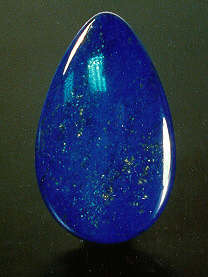Lapis lazuli differs from other gem materials because it is a “rock” composed of several minerals rather than being a single mineral as the other gemstones are. The components of lapis lazuli include sodalite minerals, calcite, and pyrite.
The sodalite minerals are the blue part, the calcite is white, and the pyrite is the “gold flecks” commonly visible in lapis lazuli. The finest quality is a dark, but still intense blue color with no visible calcite and a mere sprinkling of pyrite. “Royal blue” is a descriptive term for fine material.
All lapis lazuli is opaque. If there is quite a bit of calcite the material is a lighter blue; this can still be nice as long as there are no visible portions of calcite. As the color becomes lighter the value of lapis lazuli drops, visible calcite is a definite detriment. Quality of cutting is a value consideration also.
 |
| Lapis Lazuli (Photo by ICA/Bart Curren) |
Lapis Lazuli Gemstone Properties
| Colors: | Shades of blue |
| R.I.: | 1.50 |
| Durability: | Fairly tough |
| S.G.: | 2.70 – 2.90 |
| Treatment: | Dyeing is common |
| Hardness: | 5 – 6 |
| Availability: | Supply meets demand |
| Localities: | Afghanistan and Chile |
| Price: | Low to moderate |
| Common shapes: | Cabochons of all shapes, beads and carvings |
The finest qualities of lapis lazuli are mined in Afghanistan from a mine that has been in operation for 7,000 years! Chilean lapis lazuli generally contains large amounts of calcite.
Very inferior qualities of lapis lazuli are dyed. You can detect this by rubbing a cotton swab soaked in acetone (or fingernail polish remover) across the surface of the stone; be patient, it may take a minute or two. If blue coloring comes off and stains the cotton the material is definitely dyed.
Generally dyed material should be avoided; dyed beads can bleed onto clothing or skin if the material gets wet. Earrings and rings can fade or loose their color especially if they come in contact with strong chemicals. Be sure you know whether the material is dyed or not when you buy it. Have the seller write “natural” or “dyed” on the sales slip.
If the items is really cheap and you know it’s dyed and are aware of the potential problems then buy it. Otherwise, ask intelligent questions about lapis lazuli and ask that the seller test for you or test it yourself. This can be a lot of fun!
